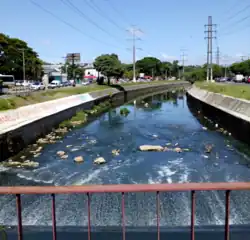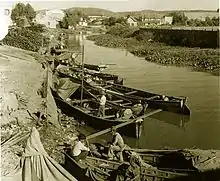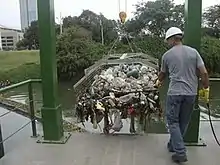| Arroio Dilúvio | |
|---|---|
 | |
| Location | |
| Country | Brazil |
| State | Rio Grande do Sul |
| Physical characteristics | |
| Source | Saint'Hilaire Municipal Natural Park, Viamão |
| Mouth | Guaíba Lake |
• coordinates | 30°02′51″S 51°14′04″W / 30.0474°S 51.2344°W |
| Length | 17 km (11 mi) |
| Basin features | |
| Cities | Porto Alegre and Viamão |
Arroio Dilúvio[1] is a brook (arroio) in Porto Alegre, Rio Grande do Sul, Brazil, that flows in areas with high population density. It was or still is known by other names: Riacho Ipiranga[2] (resulting in the name of Ipiranga Avenue), Arroio da Azenha (watermill, resulting in the names of Azenha Avenue and Azenha neighborhood), Riacho or Riachinho and even Arroio do Sabão, this being the current name of the stream that gives it its most distant source.[1][3]
Geography
.jpg.webp)
Running in an east–west direction, its most distant springs are in the Saint'Hilaire Municipal Natural Park, in Viamão.[4]
It has a length of 17,605 m from its springs to its mouth in Guaíba Lake. The canalized and rectified extension is estimated at 12 km, of which the final 10 km has a central channel between the lanes of Ipiranga Avenue, covering the route between Antônio de Carvalho Avenue and the mouth.[1]
History
The first reference made to the Arroio Dilúvio appears in a letter dated 1740, called the Jacareí River, which means river of the alligators in the Guarani language, as the divider of the sesmaria of Jerônimo de Ornelas.[1]

In the old days, the stream flowed into the Ponta da Cadeia, next to the Gasômetro Power Plant, and before reaching there it passed under the Stone Bridge (or Açores Bridge), which still exists today, near the current Açorianos Square. With the growth of the city, the creek was re-channeled to its current course. The work that changed the course of the stream, including the construction of the lanes of Avenida Ipiranga, began during the administration of Mayor Loureiro da Silva.[5]
The first canalized stretch was implemented between 1939 and 1943 from the mouth to the vicinity of Avenida João Pessoa.[6] The work took more than 40 years to be completed. In its execution, the city government was assisted by the federal government, through the National Department of Works and Sanitation (DNOS).[7]
Pollution

Until the 1950s, the Dilúvio had very clean waters, and earned its name because it used to flood the neighboring neighborhoods, such as Menino Deus or Cidade Baixa, on days of heavy rain. Currently, it is estimated that it receives about 50,000 cubic meters of sediments and waste per year, besides the sewage from three neighborhoods, requiring periodic dredging.
Currently, the Arroio Dilúvio is one of the main pollution inputs to Guaíba Lake,[8] the main public supply source of Porto Alegre. The sediments of the Dilúvio are contaminated with potentially toxic metals (Zn, Cu, Cr, Pb), with these concentrations increasing the closer to its mouth (in Guaíba Lake).[9]
In June 2011, the Federal University of Rio Grande do Sul (UFRGS) and the Pontifical Catholic University of Rio Grande do Sul (PUCRS) - both with teaching facilities located on Ipiranga Avenue, on the banks of the stream - proposed to the city government a partnership for the revitalization of the Dilúvio.[10][11][12]
To do this, the two universities wanted to adopt the model used to restore the Cheonggyecheon stream in Seoul, the capital of South Korea - which similarly flows through a large urbanized area of their city, having been heavily polluted in the past. Since its restoration, completed in 2002, the Cheonggyecheon has featured clean waters, on the banks of which local people find tree-shaded recreational areas.[13][14][15][16] In 2016, the project was reportedly stalled; the city government claims a lack of resources.[17][18]
In 2016, the Arroio Dilúvio Ecobarrier Project was created. Installed at the mouth, the project aims to collect waste that would flow into Lake Guaíba.[19]
Notorious facts
- It was found that in a two-year period (2009 to 2010), at least 20 cars fell into the Dilúvio stream due to the lack of sidewalk cords with sufficient height, because of the asphalt retreading that made them lose height over the years without having corrections made by the city government.[20]
- In November 2009, the stream became full and muddy because of a heavy rain, and a group of surfers, ignoring the pollution of the Dilúvio, surfed on its waves.[21]
 Arroio Dilúvio, between the Santana and Santa Cecília neighborhoods.
Arroio Dilúvio, between the Santana and Santa Cecília neighborhoods.
See also
References
- 1 2 3 4 Faria, Carla M.; Morandi, Iara C. (2002). A difícil recuperação de arroios em áreas urbanas - Arroio Dilúvio - Porto Alegre - RS. Pesquisa Ecossistema Revista, v. 3, p. 38-52.
- ↑ "Riacho Ipiranga". Itaú Cultural. Retrieved 2019-06-07.
- ↑ Andrade, Leonardo Capeleto de (2018). Impactos do ambiente urbano na poluição dos sedimentos do lago Guaíba. (PhD). Universidade Federal do Rio Grande do Sul. Porto Alegre.
- ↑ Alegre, Prefeitura Municipal de Porto. "SMAM". www2.portoalegre.rs.gov.br (in Brazilian Portuguese).
- ↑ Nunes, Júlia Schiedeck & Cé, Ana Rosa Sulzbach (2009). Avenida Ipiranga: Processo Evolutivo ao Longo do Século XX. PUCRS.
- ↑ Burin, Carolina Wolff (2009). O caso da canalização do arroio Dilúvio em Porto Alegre : ambiente projetado x ambiente construído. Lume inicial.
- ↑ Alegre, Prefeitura Municipal de Porto. "DEP". www2.portoalegre.rs.gov.br (in Brazilian Portuguese).
- ↑ de Andrade, Leonardo Capeleto; Tiecher, Tales; de Oliveira, Jessica Souza; Andreazza, Robson; Inda, Alberto Vasconcellos; de Oliveira Camargo, Flávio Anastácio (2018). "Sediment pollution in margins of the Lake Guaíba, Southern Brazil". Environmental Monitoring and Assessment. 190 (1): 3. doi:10.1007/s10661-017-6365-9. ISSN 0167-6369.
- ↑ dos Santos, Vinícius Maggioni; de Andrade, Leonardo Capeleto; Tiecher, Tales; de Oliveira Camargo, Flávio Anastácio (2020). "The Urban Pressure Over the Sediment Contamination in a Southern Brazil Metropolis: the Case of Diluvio Stream". Water, Air, & Soil Pollution. 231 (4): 156. doi:10.1007/s11270-020-04504-2. ISSN 0049-6979.
- ↑ "UFRGS e PUCRS podem adotar exemplo de cidade coreana para revitalizar Arroio Dilúvio - Zero Hora". GZH. 2016-08-04. Archived from the original on August 4, 2016. Retrieved June 3, 2016.
- ↑ "Assinado acordo para revitalização do Dilúvio". PUCRS. 2011-12-14. Archived from the original on 2016-08-06. Retrieved 2016-06-03.
- ↑ "UFRGS assina protocolo de cooperação para revitalizar o arroio Dilúvio". www.ufrgs.br (in Brazilian Portuguese).
- ↑ "Projeto Arroio Dilúvio: um futuro possível — Arroio Diluvio". UFRGS. 2011-11-12. Archived from the original on 2011-11-12.
{{cite web}}: CS1 maint: bot: original URL status unknown (link) - ↑ "Publicado o Marco Conceitual do Programa de Revitalização da Bacia do Arroio Dilúvio | Portal de Notícias e Eventos". 2018-07-12. Archived from the original on 2018-07-12.
{{cite web}}: CS1 maint: bot: original URL status unknown (link) - ↑ Alegre, Prefeitura Municipal de Porto. "SMAM". www2.portoalegre.rs.gov.br (in Brazilian Portuguese).
- ↑ Programa de Revitalização da Bacia do Arroio Dilúvio
- ↑ "UFRGS 'joga a toalha' em projeto do Dilúvio". issuu.com.
- ↑ "Jornal do Comércio - Projeto de revitalização do Arroio Dilúvio está parado na prefeitura". Jornal do Comércio. 2015-04-03. Archived from the original on 2015-04-03.
- ↑ "Ecobarreira do Arroio Dilúvio já reteve 250 toneladas de resíduos". Jornal do Comércio (in Brazilian Portuguese). 2022-07-19.
- ↑ "Em dois anos, ao menos 20 veículos caíram no Arroio Dilúvio, na Capital". GZH (in Brazilian Portuguese). 2011-03-30.
- ↑ "Últimas Notícias de Porto Alegre e Rio Grande do Sul". GZH (in Brazilian Portuguese).